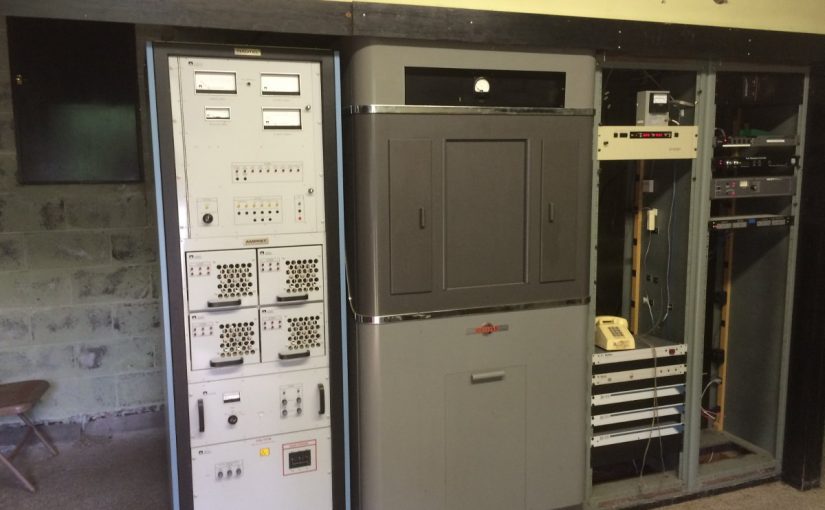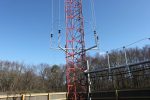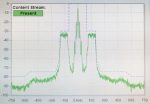I have been reading, with interest, the saga of HD Radio on the AM (AKA Medium Wave) band. First question; if it goes all digital, will we still call it AM? Of course, there are other questions and concerns:
- The proprietary nature of HD Radio, AKA MA3 or NRSC-5D as they are now calling it, is problematic. Xperi, the latest patent owner, currently (their word) has agreed to waive licensing fees for AM station owners who install their system. Is this a limited-time deal for early adopters or in perpetuity for all stations?
- The NRSC-5D tests on WWFD, Fredrick, Maryland are hopeful, but as I pointed out before, it is one station with a well-functioning antenna system. Many AM antenna systems are defective either in design or due to deterioration. Is the FCC going to start policing the AM band again to cure these self-inflicted wounds?
- Of course, the NAB wants zero oversight on the entire adventure. Under their proposal, small ownership AM stations would have a difficult time remediating interference issues from all digital co-channel stations by eliminating any required notification period, as proposed by the SBE.
- The NAB also wants to nix a 1 Hz carrier frequency requirement, which would help with both the analog and digital interference issue, saying it would be too expensive. I disagree. In this day of universal GPS timekeeping, it would be easy to implement this on all modern transmitters, especially if they were already installing an HD Radio exciter.
- Denis Jackson’s Radio World Article states that reliable coverage can be had out to 0.1 mV/m. This seems very, very optimistic given that ambient electrical noise (non-broadcast related) on the AM band is at very high levels and still climbing. Further, once the all-digital conversion starts, more and more co-channel digital interference will happen, likely cutting down that contour to a great extent. It works now but may not work later. These types of statements seem naive or perhaps disingenuous. Again, WWFD is one digital signal in a vast ocean of analog carriers.
While I am skeptical of some of the statements made in various articles and comments before the FCC, I do believe that converting the Medium Frequency band to all digital will have benefits. The BBC DRM tests carried out in 2007 (The Plymouth DRM long term trial) show that digital on MF can work. DRM has been implemented in various countries with good results.
Getting rid of the hybrid IBOC/Analog is a step in the right direction.
My concerns are the small owners who are still making a go of it on AM. Those guys still doing community radio and serving the public interest. If they choose to wait, are they going to get buried under a digital dog pile and then have to pay the full license fee later? Something like that might be the end for them.
HD Radio in and of itself is not the panacea for the AM band. Other things have to happen to make it work right. The SBE speaks extensively about ambient noise on the MF band. They are entirely correct. In addition, there are many, many AM stations that do not have compliant antenna systems. There are stations operating a DA-2 system full-time on the night pattern. There are stations operating a DA-2 full-time on the daytime pattern and power. There are stations that are supposed to turn off at night, which stay on 24/7. There are stations not reducing power to nighttime levels. The list goes on. Simply putting digital carriers on everything will not reduce station-to-station interference, especially at night.
I am cautiously hopeful that the FCC will look into the ambient noise problem, which simply cannot be over-emphasized. They would also need to re-invigorating the Enforcement Bureau. Since they closed down most of their field offices, it has been kind of a free-for-all out here.






The EB really does need to be restored to an effective force. We’ve had a pirate running on 95.5 in town for a year now. One of the other engineers in town has reported it, but no action yet.
I’m eager to see how this shakes out as well. Properly executed, it will put AM and FM stations on a level playing field. And yes, the method of delivery is irrelevant.
I’ve told my few remaining clients to start planning for it now. First by getting their antenna system checked out and making sure it’s up to snuff. I’ve got some antennas that couldn’t pass AM stereo now if they wanted to. Small bites now prevents one big bite when the time comes.
Ambient noise is a major problem, mostly from the power companies who have had no oversite. There are some 50kW stations that are unlistenable in parts of their 2 mV/m area because of it.
I’m surprised about Greg’s comment regarding the enforcement bureau not going after a pirate for a year or more. I’ve seen pirates interfering with local broadcasters here in Connecticut where they’ve been identified along with their location and the Enforcement Bureau was quick to shut them down. The recently enacted PIRATE Act law should make quick work of this now, though I believe well meaning Part 15 broadcast hobbyists may get caught up as collateral damage.
As far as the current state of HD goes, I’d much prefer to see DRM adopted, it being an open standard not tied to the business interests of some company. When I see a station’s HD sub-channels hit the skids because their licensed expire (only discovered upon reboot of the importer) I can see that being a detriment to a broadcaster. Will they make it a one-time license fee? I tend to doubt it. And how about any continued improvement to the codec? I doubt that, too. I feel a major gaff was done with the entire HD Radio debacle, which I discussed in my past Radio World article HD Radio Faces Rocky Road where a better choice of codec might have made for downloadable codec updates and perhaps a redundancy for listeners where the radio could switch between a station’s off-air signal and their companion online stream.
Bill: You make some very valid points. DRM should have been looked at as an alternative to HD Radio early on. However, as some commenters pointed out, the AM Stereo debacle looms into view and that series of events does not need to be repeated. Your point about having upgradable CODECs also makes some sense, but sometimes those firmware upgrades are a PITA. I could see this being a problem particularly in car radios where the radio suddenly stops working because the CODEC has changed.
Scott: Are your clients willing to spend money fixing AM antenna systems? I have found it very difficult to get any work done at AM sites.
There are numerous reasons bring back the EB; pirates, noise, etc. Perhaps the FCC would be willing to contract out EB functions.
Regarding 1Hz carrier frequency accuracy requirement , I would suggest one tenth of that, 0.1Hz accuracy for worthwhile reduction of interference effects of analog AM to analog AM.
A sufficiently interfering AM station carrier 0.1-0.2 Hz away will lead to gradual fading up and down over several seconds, which perhaps the AGC of the receiver can help level out to an extent.
On the other hand a lesser 1Hz accuracy could mean carriers nearly 2Hz apart (if one was + and the other -) which would have a more annoying ‘rapid fading’ of effect.
Its often the case that a beat between slightly different AM carriers leading to rapid fading up-and-down is more annoying than just hearing the other station’s audio in the background.
Regarding all Digital AM – I would be interested to hear of it being demonstrated on a portable receiver with internal ‘loopstick’ antenna. I suspect results would not be promising due to RF noise being generated by its DSP components being picked up by the loopstick. A car radio has the benefit of the antenna being at a distance from the receiver.
I agree Paul this is interesting. I have seen some of the international DRM tests – performance was pretty good. I would expect to see HD perform about as well as they are similar modulations. I do think the license fee is a bit of a read herring as is the “Open Standard” point. Factually DRM has a patent pool that charges fees for the use of technology, it is not in fact open, it is administered differently than HD Radio, in addition since there is very limited deployment of DRM, the equipment cost is more expensive than HD. License fees for HD AM and FM are single payment, only the multicast is a annual royalty, it is 3% of net revenue or $1000 – considering what it enables, I think the fee is pretty reasonable – If you are doing HD multicast and you can’t pay $1000 you have bigger problems than the fee.
BTW – I should have said I agree that the antenna system issues and other interference are large issue that need to be resolved before all digital AM gets wide adoption.
BTW HD Radio License fees are between 5k and 10k ranging from non come to commercial FM – AM is in between – these are one time fee that HD Radio will take payments of 5 years. While they do want to get paid for their intellectual property, it is much less than in the beginning, and I think there terms are pretty flexible. I know this as I just had to do a presentation on global digital radio standards so it was on top of my head.
Paul, just wanted to note I’ve finally finished reading your blog archives for fun (I started as a young ham in the 70s, then was a college DJ, and now just follow things).
I have the most unique connection to one of your frequent subjects: I was born in Bridgeport and spent plenty of days at grandmother’s house on Seaview Avenue.
It’s fascinating to read your items about the WICC site, close by the place where the amusement park was, a mile across the used-to-be bridge, from the old house that’s no longer there.
Rich – Regarding DRM, you are correct that there are fees associated with that system as well. From what I can tell, DRM on MF and HF works well but there few receivers available and they are expensive. I believe the folks at Expri would be doing themselves a favor if they allowed software developers free access to their codecs, which would making easier to develop and deploy inexpensive receivers, particularly RTL-SDRs. Something about this process needs to be made easier for the consumer, otherwise they will just keep streaming Spotify on their smart phones.
Quote:”I would expect to see HD perform about as well as they are similar modulations.”
DRM and HD both use OFDM, but the parameters are quite different, eg. the length of cyclic prefix which determines the performance in sky/ground wave interference are different by a factor of 9 (0.3ms vs 2.66ms). That is why DRM is much robust than HD.
I have no comment on the topic, but both that Ampfet and Collins cabinet are classics! I believe that matched a 21E/M as well as 20V2. That’s all. Carry on.
Chuck, You are correct, that is the phasing cabinet for the former three tower directional antenna system and the transmitter was a 21E. The station is no longer directional 5KW, however, I am reluctant to remove it because the inside looks as good as the outside does. I would donate it to a museum for preservation, if someone were interested in that. The Nautel transmitter is somewhat newer, dating to the mid nineties. That needs to have the bypass capacitors replaced in all the PA modules, else it will start losing devices.
The biggest difficulty I see is the lack of receivers. Just about everybody I know owns a radio that can receive analog AM and FM. I only know about a dozen people who own receivers that are HD / Digital capable.
Our big-dog country station is HD, and if I let the analog diversity delay get out of sync with the HD audio, I get complaints about the signal “skipping”. So I know at least some number of our listeners have HD receivers, although they may not realize it.